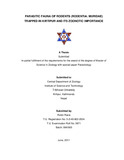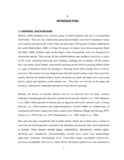Please use this identifier to cite or link to this item:
https://elibrary.tucl.edu.np/handle/123456789/3569| Title: | Parasitic Fauna of Rodents (Rodentia: Muridae) Trapped in Kirtipur and its Zoonotic Importance |
| Authors: | Rana, Robin |
| Keywords: | Rodents;Ecto-parasites;Zoonotic |
| Issue Date: | 2011 |
| Publisher: | Central Department of Zoology |
| Institute Name: | Central Department of Zoology |
| Level: | Masters |
| Abstract: | A total of 32 rodents (Rodentia: Muridae) belonging to seven species, (12 Rattus turkestanicus, 6 Rattus nitidus, 6 Rattus rattus, 3 Niviventer fulvescens, 3 Bandicota bengalensis, 1 Bandicota indica and 1 Mus cervicolar ) were trapped from five different sites of Kirtipur during 2010-2011, using live traps. Almost all rodents (100%) were found to be infected with ecto-parasites. The most prevalent ecto-parasite was Polyplax spinulosa (87.5%) followed by Laelaps echidnina (78.125%), Xenopsylla cheopis (59.375%) and Ornithonyssus bacoti (28.125%). A total of 31 rodents (15 males and 16 females) were infected with endo-parasites thus giving an overall infection rate of 96.875%. Statistically [2(cal) = 2.0645 and 2(tab) = 3.84, 1 d.f., P < 0.05] there was no major difference in the infection rate among the males and females. Ten different endoparasites were identified: 1 trematode, 2 cestodes, 6 nematodes and 1 acanthocephalan species. The identified endo-parasites belonged to trematodes: Schistosoma sp.; nematode: Syphacia sp., Nippostrongylus sp., Capillaria hepatica, Heterakis sp., Physaloptera sp. and Aspiculuris sp.; cestodes: Hymenolepis diminuta, strobilocercus larvae of Taenia taeniaeformis and acanthocephalan: Moliniformis dubius. Among the ten species of helminthes identified, six species (60%) have been incriminated as zoonotic. The most prevalent helmith type was the cestode Taenia taeniaeformis (strobilocercus larva) (62.5%) followed by nematode Syphacia sp. (53.125%) and cestode Hymenolepis diminuta (12.5%). Prevalance of infected liver by the eggs of Capillaria sp. was 43.75%. The following parasites Schistosoma sp., Syphacia sp., Capillaria hepatica, Hymenolepis diminuta, Taenia taeniaeformis, and Moliniformis dubius are considered as zoonotic and are of medical importance. R. nitidus was found to harbor maximum number of endo-parasite than other rodent species. Statistically [F(cal) = 11.196 and F(tab) = 2.175,(for v1=6 and v2=84), P < 0.05] it was found that there was significant difference in the prevalence of parasites between the seven different rodent species. The highest prevalence of parasitic infection in rodents was found in household areas (28.125%), followed by agricultural field (25%), departmental stores (21.875%), vegetable market (15.625%) and garbage site (6.25%). The diversity and prevalence of parasites were statistically [F(cal) = 7.8 and F(tab) = 2.447,(for v1=4 and v2=56), P < 0.05] found to be affected by the type of sites, with household area being at high risk area for zoonotic disease transmission. |
| URI: | http://elibrary.tucl.edu.np/handle/123456789/3569 |
| Appears in Collections: | Zoology |
Files in This Item:
| File | Description | Size | Format | |
|---|---|---|---|---|
| Cover.pdf | 52.1 kB | Adobe PDF |  View/Open | |
| Chapter.pdf | 1.64 MB | Adobe PDF |  View/Open |
Items in DSpace are protected by copyright, with all rights reserved, unless otherwise indicated.
